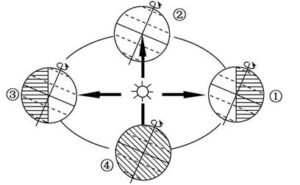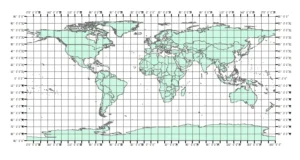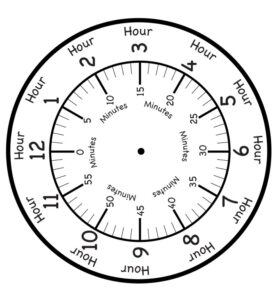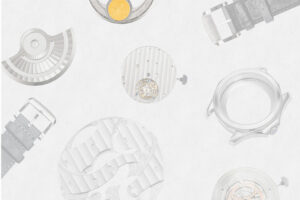Daniel J. Bufenstine once said, “Man’s first and greatest discovery is time.” Time is one of the most basic physical quantities, and the accuracy of contemporary time measurement has reached a very precise level.
Looking at the history of measuring time, we are constantly looking for periodic motion and using a fraction of the motion cycle as the basic unit of time measurement, one second.
The flow of shadows, dust, water, and the flow of the event itself are all transformed into the movement of time and become a faithful record of human activities on earth. Only clocks can mark the week, month, year, every second, every minute, every hour, and every day, thus liberating human beings from the monotonous cycle of nature.
Measurement of time
Time
There is neither a starting point nor an ending point, and a straight line can be used to represent the time scale. Time has the property of no return and always flows in one direction, from the past without a source, through the present, and continuously flowing into the endless future.
Measurement of time
Time can be measured, and various clocks are instruments for measuring time.
There are two types of measurement of time.
1. Time measurement
Measure an instant of time (a point on a time scale).
Time measurement requires a unit of measurement and a starting point for measurement. Midnight is the starting point for time measurement. For example, the train departure time is: 17:30, “hour” and “minute” are the units of measurement.
2. Period measurement
Measures the interval between 2 instants (two points on a time scale).
Period measurement only requires measurement units and does not require a measurement starting point. For example, the newly opened high-speed train from Beijing to Guangzhou only takes 8 hours from driving to arrival. “Hour” is the unit of measurement and has nothing to do with the starting point.
Establishment of time benchmark
The basis for measuring time in ancient times relied on the movement of celestial bodies. The so-called “work begins at sunrise and rests at sunset.” Just as you need a ruler to measure length, you also need a benchmark to measure time. https://watcheshome.com/

True solar day
The period when the center of the sun passes through local noon twice in a row is called a day.
Due to changes in the distance between the earth’s orbit and the sun, the speed of the earth’s rotation also changes, so the length of each true solar day is different. The longest and shortest true solar day differ by dozens of minutes. Therefore, using the true solar day as the basis of time is inaccurate.
Mean solar day
The ancient Egyptians divided a day into 24 hours, an hour into 60 minutes, and a minute into 60 seconds
In 1820, French scientists held a meeting and decided to express the length of a day by the “average” of one year of the Earth’s rotation, which was recognized by the scientific community as the benchmark for time measurement. There are 86,400 mean solar seconds in a mean solar day.
Almanac seconds
In 1939, British scientist Jones discovered that the “Earth’s rotation” cycle changed significantly every year after long-term astronomical observations. He believed that the “mean solar day” time base established based on the Earth’s rotation was also unstable.
In 1956, scientists proposed establishing a new timing benchmark based on the “Earth’s revolution”. However, the Earth’s annual revolution period is also different, so the length of the solar return year at 12 noon on January 1, 1900 was used as the measurement benchmark. . This benchmark was obtained after years of research, and its accuracy has been greatly improved.
1/31556925.9747th of the time it takes for the Earth to orbit the sun once is regarded as one almanac second. The almanac second has been officially used since 1960.
Atomic second
The Birth of the Atomic Second
With the advancement of science and technology, researchers discovered that atoms exhibit an exceptionally stable vibration frequency. This breakthrough led to a revolutionary change in how time is measured.
In 1967, the 13th International Conference on Weights and Measures officially decided to replace the traditional astronomical second with the atomic second. Unlike the old almanac-based definition, the new standard was derived from the precise oscillations of atoms, marking a new era in timekeeping.
The Definition of the Atomic Second
The international standard second is now defined using an atomic clock, achieving an astonishing level of precision — accurate to within one second over three million years.
Specifically, when a Cesium-133 atom (Cs-133) transitions between two hyperfine energy levels in its ground state, it emits or absorbs electromagnetic radiation. The duration of 9,192,631,770 oscillation cycles of this radiation equals one second by international definition.
A New Era of Time Measurement
The International Standard Second officially took effect at 00:00 UTC on January 1, 1972, ending the era in which time standards were based on complex astronomical observations and celestial mechanics.
Since then, the definition of “second” has been completely independent of celestial motion, and timekeeping responsibilities have transitioned from astronomical observatories to national metrology laboratories around the world.
2. Globally unified timekeeping method – zone time system
Time zone
Before the establishment of the zone time system, there were no certain guidelines for clocks around the world. It is said that in 1880, there were three clocks at the Buffalo train station in New York State: one showed the local time in Buffalo, one showed the time in New York City, and the other showed the time in Columbus, Ohio. The confusion can be seen Just imagine.
In 1879, Canadian railway engineer Volemin first proposed the concept of “time zones” in the world. In 1883, the American Railway Bureau held a meeting and decided to divide the country into 4 time zones, with each time zone differing by 1 hour. This is The earliest time zone system.
In 1884, at the International Meridian Conference in Washington, it was decided to extend the zone time system worldwide. watches home watch custom
Zone time system
The Zero Time Zone
The Zero Time Zone is centered on the prime meridian, which passes through the Royal Observatory in Greenwich, London, England. It extends 7°30′ east and west from this meridian, covering a total span of 15 degrees of longitude.
-
In the Eastern Hemisphere, the zone extends from 7°30′E to 22°30′E, with 15°E as its central meridian.
-
In the Western Hemisphere, it extends from 7°30′W to 22°30′W, with 15°W as the central meridian.
Following this pattern, the Earth is divided into successive time zones both eastward and westward. Interestingly, the East 12th Zone and West 12th Zone overlap at the 180° meridian, which also serves as the International Date Line.
2. The Zone Time System
The Zone Time System divides the Earth’s 360 degrees of longitude into 24 time zones, each spanning 15 degrees — the distance the sun appears to move across the sky in one hour.
This system greatly simplified global timekeeping by reducing the confusion caused by local solar times. Instead of hundreds of local times, there are now only 24 standard time zones, with each adjacent zone differing by exactly one hour.
Thanks to its simplicity and consistency, the zone time system has been adopted worldwide for over a century, forming the foundation of modern international time coordination.
3. Commonly used timing nouns
Universal time
Universal time is also called Greenwich time. The International Meridian Conference held in Washington in 1884 decided to locate the meridian passing through the Greenwich Observatory in England as the zero degree meridian (also known as the prime meridian). The zero time zone uses the local time passing through this meridian as the standard time.
Note: Greenwich Mean Time represents 12:00 noon; the dateline represents 24:00 midnight.
International Date Line
Referred to as “Dateline”
After universal time and universal time zones are determined, where to start calculating a new day on earth has become a new question.
Before the “date line” is determined, we often encounter such a problem: According to the zone time system, when Beijing is 20:00 on Monday, extrapolating eastward, the time in the East 12 time zone should be 0:00 on Tuesday; Extrapolating westward, the time in the 12 West time zone should be 24:00 on Monday. So at the same moment, in the same time zone, is it 0:00 on Tuesday or 24:00 on Monday?
In order to solve this problem, international organizations held another meeting and finally decided to use a line near the 180° longitude as the “date line”. In order to avoid some islands, the date line is no longer a straight line and does not pass through any land except Antarctica.
Each day on Earth begins at the dateline, which is the earliest point of each day on Earth.

1. The International Date Line and Date Change Rules
At the International Meridian Conference of 1884, delegates established not only the prime meridian but also the rules for changing dates across the International Date Line (IDL).
The principle is simple:
-
When traveling from west to east across the Date Line, one subtracts a day.
Example: If you cross the line on June 8, the calendar date is adjusted backward to June 7, and the next day will again be June 8. -
When traveling from east to west, one adds a day.
Example: If you cross the line on August 9, the date becomes August 10, and the next day is August 11.
With this rule in place, the world gained a consistent and logical system for handling the transition of dates, ensuring there would be no confusion about days and dates across different regions.
2. The Leap Second: Keeping Atomic Time in Sync with Earth
The concept of the leap second was introduced in 1972, following the adoption of the International Standard Second, which is based on atomic time rather than astronomical observation.
Its purpose is to compensate for the tiny variations in the Earth’s rotation speed, ensuring that atomic time (TAI) and astronomical time (UT1) remain synchronized. In essence, the leap second acts as a fine-tuning adjustment to keep scientific time aligned with natural time.
-
A leap second may be added or subtracted roughly every few years, depending on the measured drift.
-
These adjustments typically occur at the end of June 30 or December 31.
-
The International Earth Rotation and Reference Systems Service (IERS) officially announces whether a leap second will occur in a given year.
Although critical for scientific accuracy, leap seconds have no noticeable effect on daily life. They are mainly relevant to astronomy, satellite navigation, and precision timing systems that depend on exact synchronization between atomic clocks and the Earth’s rotation.
World clock
The world clock is designed based on the principle of the zone time system. In modern times, many clocks have a world time function, that is, the 24-hour hour circle moves clockwise, and its transmission ratio to the hour wheel is 1:2; the hour hand rotates 2 times, and the 24-hour hour circle only rotates once. , is a world clock with a relatively simple structure.

The outermost circle of the world clock is the geographical circle, which is divided into 24 equal parts in the order of time zones. In each equal part, 1~2 important cities in each time zone are marked. Generally, the city name on the place name circle does not change, but the time can be adjusted. https://watcheshome.com/







